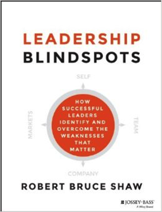July 2015: In This Issue
Welcome to the July issue of A New Leaf! Hopefully, your transition through the first six months of the year has been a successful one. With the completion of the second quarter, many companies are coming to grips with the relative effectiveness of their planning process and current year execution. If shortfalls from plan exist, they may be arising from a poor strategic/budgeting process, ineffective execution, unfocused leadership or a combination of these and a number of other factors. All of these ultimately reflect on your leadership capabilities.
This quarter’s issue deals with an important leadership challenge; acknowledging and overcoming their own blindspots. We all have them. Whether they become a source of pain for your organization is your choice. Choosing not to address them may represent the biggest challenge your organization faces.
If not addressed, your blindspots can cause undue and unnecessary stress on your organization. I’m excited to offer a new assessment addressing the level of stress on individuals and organizations. Please email me requesting more information on this important topic at mkutchin@seechangemanagement.com .
As you look forward to the remaining challenges of 2015, consider how much of what needs to be done is impacted by your leadership capabilities. Addressing your blindspots now is an important first step in making sure your team is positioned to deliver on its plan for the remainder of this year and beyond.
- Mike

Book Review: “Leadership Blindspots” by Robert Bruce Shaw
The one characteristic all great leaders share is the constant desire for self improvement. Good can always be better. In Leadership Blindspots, Robert Bruce Shaw offers a pathway to how leaders can improve their performance by clarifying “what blindspots are, why they matter and how to surface and overcome them “.
Shaw defines a “blindspot” as “an unrecognized weakness or threat that has the potential to undermine a leader’s success”. They almost always are recognizable if one chooses to look for them. Blindspots often share two surprising qualities; leadership strengths are often found in close proximity to them and they frequently have a tendency to reappear after being addressed. Awareness does not mean they will disappear.
Leaders dare not underestimate the importance of these behavioral characteristics as “blindspots matter because leadership matters”. They are worthy of attention because the cost of neglecting them can be so high!” Viewing team members as being more talented than they are or holding distorted views of their organization can be debilitating to a leader’s success.
Blindspots arise as leaders attempt to balance their individual bias to be confident with their need to manage their own self doubt. An overconfident leader will often have many blindspots while the opposite is true with one who’s over realistic and overwhelmed by the obstacles they are facing. In both cases, addressing their own biasness is critical for the organization.
Shaw sets forth the following three layers of blindness:
- Lack of Awareness: The most extreme form of a blindspot arising from a complete lack of existence of a weakness or threat on the part of a leader
- Faulty Assessment: This blindness is commonly referred to as denial, whereby the leader refuses to fully face the unwelcome realities that pose a risk to them and/or their organizations, even though he is aware of its existence
- Failure to Act: This arises from a leader’s unwillingness or inability to address a known weakness or threat
Shaw lists 20 common blindspots in which leaders lack “awareness” of their weaknesses. Those associated with “self” and the “team” are detailed below:
SELF AWARENESS BLINDSPOTS:
- Overestimating your strategic capabilities
- Valuing being right over being effective
- Failing to balance the what with the how
- Not seeing your impact on others
- Believing the rules don’t apply to you
- Thinking the present is the past
TEAM AWARENESS BLINDSPOTS:
- Failing to focus on the vital few
- Taking for granted your team model
- Overrating the talent on your team
- Avoiding the tough conversations
- Trusting the wrong individuals
- Not developing real successors
Shaw spends considerable time setting forth actions designed to surface and overcome your own blindspots. As a starting point, he challenges leaders to continue to spend focused time both inside and outside the organization to maintain their awareness level in the four key areas of:
- Customers and markets
- Frontline challenges
- Awareness of high potentials
- Awareness of outsiders
In addition to increasing their awareness level, all leaders are encouraged to seek out that which disconfirms what you personally believe. One of the most revealing results of decision making research is that people tend to see what they want to see…and they interpret new information within the context of their existing beliefs. This greatly hinders the ability of you as a leader to recognize the need for personal and organizational change and ultimately the necessity of altering how you view your people, business and strategies.
To specifically counter these natural but harmful tendencies, leaders are encouraged to seek out and ask questions specifically designed to surface disconfirming data about their:
- Leadership
- Team
- Organization
- Markets
Increasing your understanding of your personal and organizational challenges requires the leader to develop peripheral vision as a means of discerning what others miss. Shaw reinforces with leaders the absolute need to know their team, pay attention to behavioral flags, create openings for contrarians and develop the ability to become an effective listener.
Building a strong team is one of the most effective ways for leaders to surface and manage their own blindspots. Taking action in the following areas helps build the kind of team necessary to address these challenges:
- Hire a group of smart, diverse and passionate people
- Focus the team on a few priorities
- Embrace a high level conflict
- Ensure one voice on execution
In addition to these key strong team characteristics, leaders are encouraged to establish a network of trusted advisors to assist them in dealing with their own challenges. In building this network, leaders should look to target specific areas where they need advice, matching the type of advisor to these specific needs. Types of advisors include knowledge experts, coaches, mentors or sponsors, all designed to bring a sense of realism to the leader that they may not find on their own.
How high is your awareness of your blindspots? Have you taken time to identify them? If so, how successful have you been in addressing them? Shaw includes in “Leadership Blindspots” a self assessment survey all leaders are encouraged to take. This provides important feedback as to next steps in your personal development. Choosing not to consider such a survey may tell you something about a personal blindspot you may have. The success of your organization is directly correlated with your desire for self improvement. Good luck in moving forward in this important leadership area.
©2013 See Change Management. All Rights Reserved. Site credit


